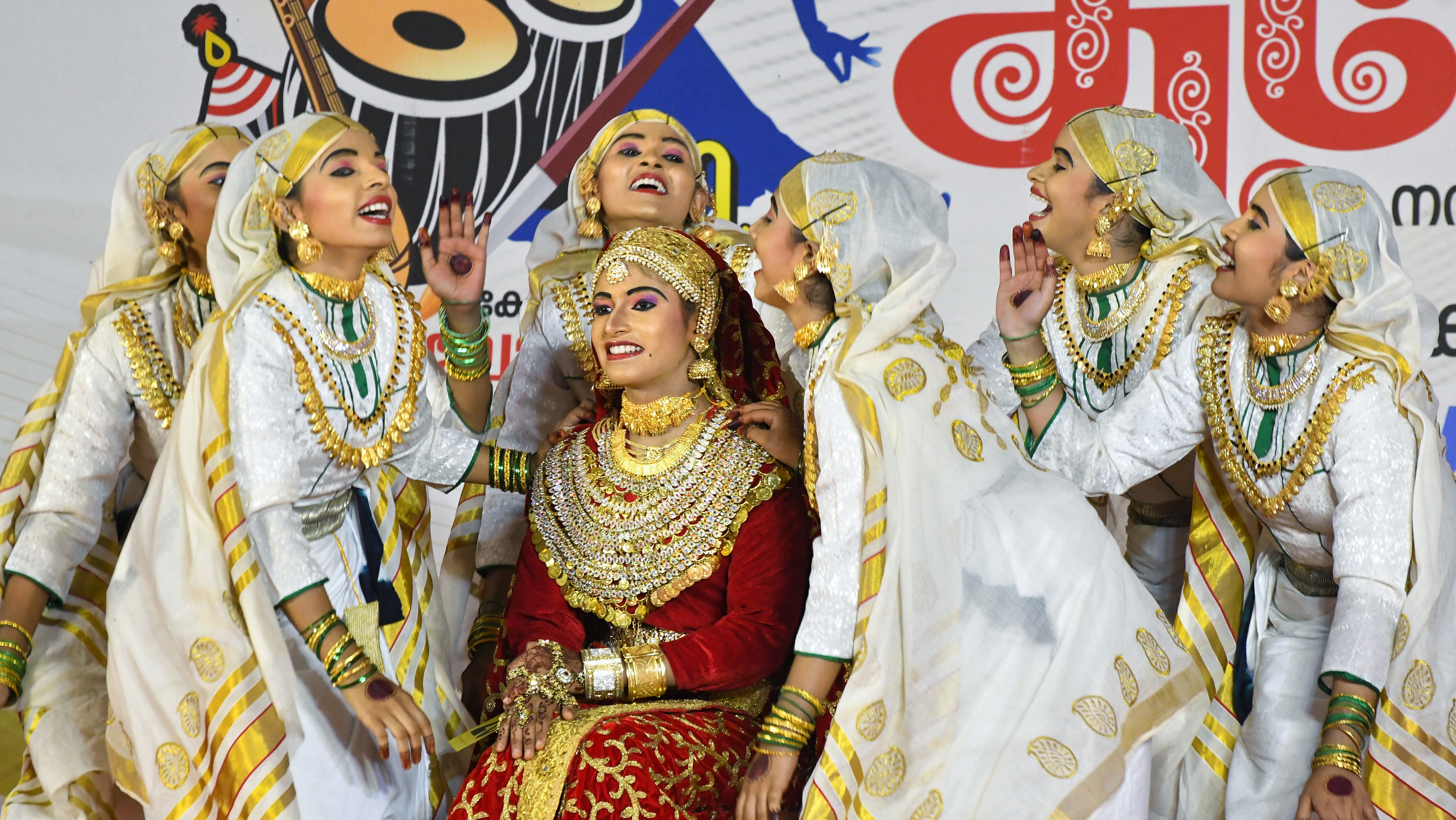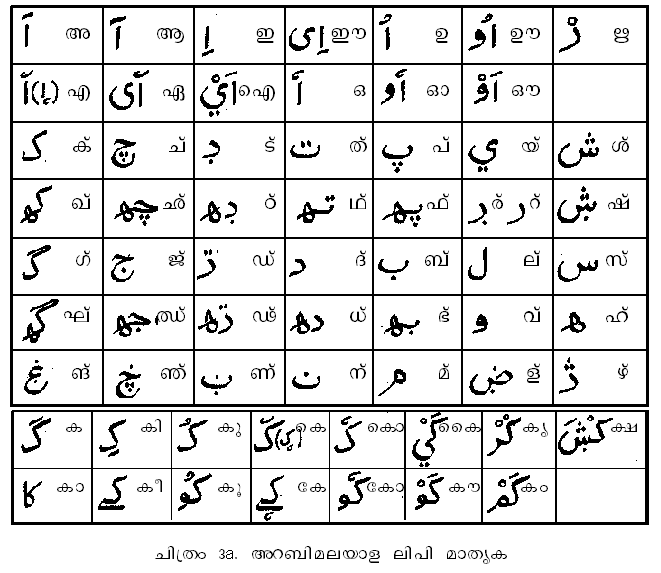|
Ishal
Ishal is the melodic framework within which Mappila Songs are composed."Mappila Muslims: A Study on Society and Anti Colonial Struggles" By Husain Raṇṭattāṇi. Though identical to tala(metre (music)) and raga of Indian music, it has influences from the ancient folk songs of Kerala and Arabian musical traditions. Ishals with its distinct tunes convey the emotion and mood of the lyrics being rendered. As mappila songs are also used in mappila performing arts like Oppana, Kolkali, Duffmuttu, etc.; the change in ishals changes the dance moves. Abdurahiman.K.P "Mappila heritage: A study in their social and cultural life" Thesis. Department of History, University of Calicut, 2004. Chapter~7 'Mappila Tradition In Folk Arts'. Ishals like Kuthirabaravu / Kuthirathalam meaning 'horse rhythm' gives the audience the feel of a galloping horse, with its distinctive rhythmic rendering. Much of the recorded sources of ishals are Mappila literary works written in Arabi-Malayalam ... [...More Info...] [...Related Items...] OR: [Wikipedia] [Google] [Baidu] |
Mappila Songs
Mappila songs (or ''Mappila Paattu'') are a folklore Muslim song genre rendered to lyrics, within a melodic framework ( Ishal), in Arabi Malayalam by the Mappilas of the Malabar region in Kerala, India. Mappila songs have a distinct cultural identity, while at the same time remain closely linked to the cultural practices of Kerala. The songs often use words from Persian, Hindustani, and Tamil, apart from Arabic and Malayalam, but the grammatical syntax is always based in Malayalam. They deal with themes such as religion, love, satire, and heroism, and are often sung at occasions of birth, marriage, and death. ''Mappila Paattu'' form an integral part of the heritage of Malayalam literature today and is regarded by some as the most popular branch of Malayalam literature, enjoyed by all Malayali communities in Kerala and Beary speaking communities of Karnataka .Pg 7-14, Mappilappattu - Padhavum Padhanavum ( Mappila songs - Study and Lessons) - Balakrishnan Vallikkunnu and ... [...More Info...] [...Related Items...] OR: [Wikipedia] [Google] [Baidu] |
Tala (music)
A tala ( IAST ''tāla'') literally means a 'clap, tapping one's hand on one's arm, a musical measure'. It is the term used in Indian classical music similar to musical meter, that is any rhythmic beat or strike that measures musical time. The measure is typically established by hand clapping, waving, touching fingers on thigh or the other hand, verbally, striking of small cymbals, or a percussion instrument in the Indian subcontinental traditions. Along with ''raga'' which forms the fabric of a melodic structure, the ''tala'' forms the life cycle and thereby constitutes one of the two foundational elements of Indian music. ''Tala'' is an ancient music concept traceable to Vedic era texts of Hinduism, such as the '' Samaveda'' and methods for singing the Vedic hymns. The music traditions of the North and South India, particularly the ''raga'' and ''tala'' systems, were not considered as distinct till about the 16th century. There on, during the tumultuous period of Islamic rul ... [...More Info...] [...Related Items...] OR: [Wikipedia] [Google] [Baidu] |
Metre (music)
In music, metre ( Commonwealth spelling) or meter (American spelling) refers to regularly recurring patterns and accents such as bars and beats. Unlike rhythm, metric onsets are not necessarily sounded, but are nevertheless implied by the performer (or performers) and expected by the listener. A variety of systems exist throughout the world for organising and playing metrical music, such as the Indian system of '' tala'' and similar systems in Arabic and African music. Western music inherited the concept of metre from poetry, where it denotes: the number of lines in a verse; the number of syllables in each line; and the arrangement of those syllables as long or short, accented or unaccented. The first coherent system of rhythmic notation in modern Western music was based on rhythmic modes derived from the basic types of metrical unit in the quantitative metre of classical ancient Greek and Latin poetry. Later music for dances such as the pavane and galliard consisted of m ... [...More Info...] [...Related Items...] OR: [Wikipedia] [Google] [Baidu] |
Raga
A ''raga'' or ''raag'' (; also ''raaga'' or ''ragam''; ) is a melodic framework for improvisation in Indian classical music akin to a musical mode, melodic mode. The ''rāga'' is a unique and central feature of the classical Indian music tradition, and as a result has no direct translation to concepts in classical European music. Each ''rāga'' is an array of melodic structures with musical motifs, considered in the Indian tradition to have the ability to "colour the mind" and affect the emotions of the audience. Each ''rāga'' provides the musician with a musical framework within which to improvise. Improvisation by the musician involves creating sequences of notes allowed by the ''rāga'' in keeping with rules specific to the ''rāga''. ''Rāga''s range from small ''rāga''s like Bahar (raga), Bahar and Shahana that are not much more than songs to big ''rāga''s like Malkauns, Darbari and Yaman (raga), Yaman, which have great scope for improvisation and for which performances ... [...More Info...] [...Related Items...] OR: [Wikipedia] [Google] [Baidu] |
Oppana
Oppana ( ml, ഒപ്പന) is a popular form of social entertainment among the Mappila (Kerala Muslims) community of Kerala, South India, prevalent throughout Kerala, especially in Malabar. The Term Oppana is believed to be originated from the Arabic word "Affna". Oppana is traditionally used in various important cultural ceremonies, and in particular, is a component of all Mappila weddings. In Kerala, this art form has been revived with much popularity on the performing stages of the Youth Festivals of the student community. Oppana is generally presented by females, numbering about fifteen, including musicians, on a wedding day. The bride dressed in all finery, covered with gold ornaments and her palms and feet adorned with an intricately woven pattern of ''mylanchi'' (henna), sits amidst the circle of dancers. She is the chief spectator sitting on a peetam (chair), around which the singing and dancing take place. While they sing, they clap their hands rhythmically and move aroun ... [...More Info...] [...Related Items...] OR: [Wikipedia] [Google] [Baidu] |
Arabi-Malayalam
Arabi Malayalam (also called Mappila Malayalam and Moplah Malayalam) is the traditional Dravidian language of the Mappila Muslim community. It is spoken by several thousand people, predominantly in the Malabar Coast of Kerala state, southern India. The form can be classified as a regional dialect in northern Kerala, or as a class or occupational dialect of the Mappila community. It can also be called a vernacular in general, or as a provincial patois, with the latter label being increasingly applicable in Colonial times. All the forms of the Malayalam language, including Mappila, are mutually intelligible.Subramoniam, V. I. (1997). ''Dravidian Encyclopaedia''. Vol. 3, Language and literature. Thiruvananthapuram (Kerala): International School of Dravidian Linguistics. pp. 508-09/ref> The Mappila form shows some lexical admixture from Arabic and Persian.Krishna Chaitanya. ''Kerala. India, the Land and the People.'' New Delhi: National Book Trust, India, 1994/ref> The variety ... [...More Info...] [...Related Items...] OR: [Wikipedia] [Google] [Baidu] |
Mappilas
Mappila Muslim, often shortened to Mappila, formerly anglicized as Moplah/Mopla and historically known as Jonaka/Chonaka Mappila or Moors Mopulars/Mouros da Terra and Mouros Malabares, in general, is a member of the Muslim community of same name found predominantly in Kerala and Lakshadweep Islands, in southern India. Muslims of Kerala make up 26.56% of the population of the state (2011), and as a religious group they are the second largest group after Hindus (54.73%). Mappilas share the common language of Malayalam with the other religious communities of Kerala.Miller, Roland. E., "Mappila" in "The Encyclopedia of Islam". Volume VI. E. J. Brill, Leiden. 198 pp. 458–56. According to some scholars, the Mappilas are the oldest settled native Muslim community in South Asia. In general, a Mappila is either a descendant of any native convert to Islam or a mixed descendant of any Middle Eastern — Arab or Persian — individual.Hafiz Mohamad, N. P. "Socioeconomic determinants of ... [...More Info...] [...Related Items...] OR: [Wikipedia] [Google] [Baidu] |
Indian Classical Music
Indian classical music is the classical music of the Indian subcontinent. It has two major traditions: the North Indian classical music known as '' Hindustani'' and the South Indian expression known as '' Carnatic''. These traditions were not distinct until about the 15th century. During the period of Mughal rule of the Indian subcontinent, the traditions separated and evolved into distinct forms. Hindustani music emphasizes improvisation and exploration of all aspects of a raga, while Carnatic performances tend to be short composition-based. However, the two systems continue to have more common features than differences. The roots of the classical music of India are found in the Vedic literature of Hinduism and the ancient ''Natyashastra'', the classic Sanskrit text on performing arts by Bharata Muni., Quote: "The tradition of Indian classical music and dance known as ''Sangeeta'' is fundamentally rooted in the sonic and musical dimensions of the Vedas (Sama veda), Upanisha ... [...More Info...] [...Related Items...] OR: [Wikipedia] [Google] [Baidu] |
Indian Folk Music
Indian folk music is diverse because of India's vast cultural diversity. It is sung in various languages and dialects throughout the length and breadth of this vast nation and exported to different parts of the world owing to migration. Tamang Selo Tamang Selo is a musical genre of the Tamang people and widely popular amongst the Nepali speaking community in India and around the world. It is usually accompanied by Tamang instruments, the Damphu, Madal and Tungna. although modern instruments have found their way into the compositions these days A Selo could be very catchy, attractive and lively or slow and melodious and is usually sung to express love, sorrow and stories of day-to-day life. Hira Devi Waiba is hailed as the pioneer of Nepali Folk songs and Tamang Selo. Her song 'Chura ta Hoina Astura' (चुरा त होइन अस्तुरा) is said to be the first Tamang Selo ever recorded. Waiba has sung nearly 300 songs in a career spanning 40 years. After Waiba's d ... [...More Info...] [...Related Items...] OR: [Wikipedia] [Google] [Baidu] |
.jpg)
.jpg)





